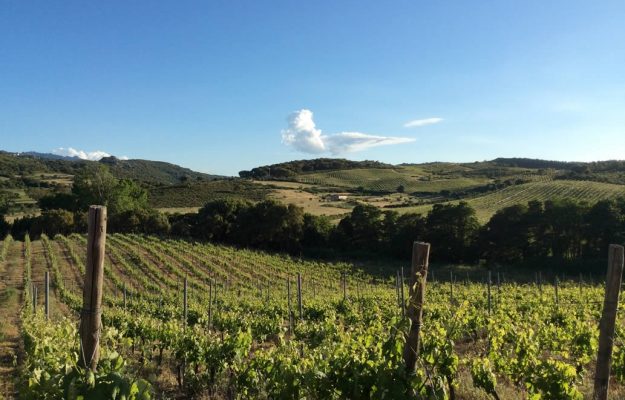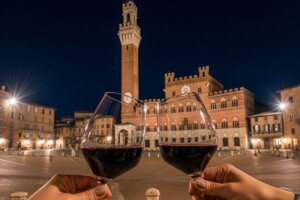Climate change has caused practical and dramatic consequences in everyday life in the past and is continuing to do so, especially in agriculture. Every year, the UN, together with IPCC - Intergovernmental Panel on Climate Change, cross-checks the scientific data processed by organizations in various countries. Their 2023 report revealed that to limit the average increase in temperatures to 1.5 degrees over the next few years, we must reduce total CO2 emissions 60% by 2030. This would seem to be a utopian goal that humanity cannot afford, but at the same time, it forces us to deal with serious consequences. Several vulnerable places have already been devastated by climate change, and we will have to learn to live almost everywhere with more and more frequent and intense climatic events, such as hail and thunderstorms. We need to be well equipped and rely on science, in viticulture as well, to face this new scenario. This was the main topic discussed at the “Porto Cervo Wine & Food Festival” (sponsored by the Costa Smeralda Area and managed by Marriott International, through May 14th), during the talk show on “Climate Change”, hosted by Alessandro Torcoli, Director of the historic magazine “Civiltà del Bere”. Other participants included Luca Mercenaro, professor of Viticulture at the University of Sassari, Andrea Pala, junior consultant of the leading wine companies in Sardinia, and Davide Sordi, Area Manager of North West Italy & Sardinia Vivai Cooperativi Rauscedo.
“The winegrower is suffering more than the grapevine”, Professor Luca Mercenaro, said, “ which is all over and cultivated everywhere. Climate change, in Sardinia as well, has made the winemaker deal with problems he did not know about, though the plants are so far responding very well. The current scenario is advising us that in the future, native varieties will most likely encounter difficulty responding to climatic events. There were periods in the past that had to deal with climate change, too. For instance, viticulture in Ancient Roman times reached as far as London. The situation is similar, now, though the speed moving the vine is very different, so, we have to change our cultivation techniques quickly, also. Everything starts with the grape, and a good grape is the result of three pillars - environment, plant genetics and human work, which bring these elements together with their own skills. The challenge now is to understand which techniques are immediately most useful to the vineyards we planted between 5 and 50 years ago. Tomorrow, instead, we will have to understand, through new clonal and massal selections, how plants will be able to face the new climatic scenarios better”, the Professor of the University of Sassari, continued.
“The IPCC has also developed future scenarios, from the most optimistic to the most pessimistic, in which the temperature will increase as much as 3-4 degrees. In this context, a study on Torbato (a typical Sardinian variety, ed.), showed that in 2050 budding would take place in mid-February, and ripening by the end of July - almost a month earlier than today, with evident risks linked to frosts, and not only. We need cultivation techniques to mitigate the effects of these changes. And, we need a National program to establish new varieties so we can plant new genetic material in the existing ones, based on predictions of climate scenarios. The older vines have already provided the answer, since they resist better than the young ones, mainly due to morphological reasons. The older vine naturally controls production and has a more developed root system, so it deals with dry summers much better. Further, it stores sugars in the old wood and sends them to the grape bunch, which is why longer-lived plants guarantee better quality. At the genetic level, in older plants certain genes move earlier, to prevent stress, thus slowing growth, or decreasing the angle of the leaf. Having a longer-lived and more mature wine heritage, especially today, as global consumption is decreasing, is the first response to climate change”, Luca Mercenaro continued, “and we must apply the same principle to new plants, which should not be forced into production terms. Climate change is bringing back lost varieties, those that our grandparents had left behind because they did not respond well to the conditions at that time, while instead, they would adapt very well to today’s landscape”.
Speaking of wine heritage, besides the plants, “rootstocks are an essential tool today, but have not been studied in depth”, Davide Sordi (Vivai Rauscedo) explained. “We have about seventy rootstocks registered in the National Register, all usable, and established at the beginning of the 20th century, but research has stopped for over a century, so only five rootstocks cover 80% of the Italian vineyard, finding extremely different conditions and soils. There are several studies on the microbiome, how it affects the immune system and reacts to the relationship between scion and rootstock, determining new dynamics on the final product. However, the rootstock must also respond to new needs, like drought which is the real challenge, especially where irrigation cannot be used, risking losing the plant, not just production”.
One of the most relevant innovations is “the M, which Professor Attilio Scienza studied. It was a new tool, created in the 1980s, when universal rootstocks were being searched, and it responds to every need. Out of thousands of crossings, four have been selected, which guarantee better water management efficiency, using 30% less water, as well as fundamental results for phenological ripening. They are rootstocks with a vision, based on oenological feedback”, Davide Sordi said.
Let’s now shift our attention towards trends in the vineyard, and the grape trade exchange. “The three-year period dedicated to red grape plantings has just ended. Southern Italy worked very hard, and planted many International varieties, but this year there is a block, which is mainly due to the International situation. In Sardinia, Vermentino is the most popular white berry variety, and it is continuing to be planted throughout the Tyrrhenian basin, from Sicily to Lazio and Liguria. We must always pay close attention to bubbles and their varieties of choice, while there is a significant return to Pinot Noir and Chardonnay, acting as a counterpart to Glera, because the Classic Method - that is, Franciacorta, Trentodoc and Alta Langa - is the leader of an important trend” , the Manager of Vivai Cooperativi Rauscedo concluded.
From the vineyard to the winery, “many problems need to be faced, while climate change also has direct and crucial effects on the technical and commercial side”, the oenologist Andrea Pala, said. “The market is demanding lighter wines, but the heat is pushing us to produce wines that have higher alcohol content. Collaboration with agronomy, therefore, has become fundamental. We need excellent grapes, but fermentation kinetics are not that controllable, though using today's technologies it is possible, for instance, to manage temperature, accelerate fermentations, or use selected yeasts, which use more or less sugar to make alcohol. However, the organoleptic characteristics are affected, which we cannot afford because our commercial success is based on them”.
Furthermore, “overripe grapes lose freshness and acidity, keeping us at a distance from market demands. Increasing the Ph is harmful to the quality and life of the wine, as the acidity would be too low. Another problem is phenolic ripening, difficult to obtain as the sugar concentration is too high, which is what happened in 2022, the water-stressed plants in stagnation had sugar concentration linked only to the pulp, while the plant got the water directly from the grapes. Aromatic and colouring substances are in the skin, so we can try to optimize maceration times, extracting the maximum, through cryomaceration, or using certain enzymes that split the cells, releasing the aromatic and colouring substances”.
“Almost always”, continues Pala continued, “the winemaker is considered a chemist, but using technology is fundamental. Indigenous yeasts often risk producing wines with significant sugar residues that would be an enormous problem for the market, which is why it is useful to use selected yeasts. Sulfur dioxide, on the other hand, is a preservative, produced naturally as well as added, and it is found in all food products. In wine, it is found to an extremely lesser extent than, for instance, those found in cured meats. Technology is useful, if it does not alter the product; after all, we are talking about natural products.
Another effect of “climate change” is the instability of wines, which means a greater use of energy is needed to bring them back to the right conditions. In addition, there are the fundamental aromatic aspects. For instance, if there is no sudden change in temperature between day and night, which in Gallura, in Sardinia, usually lasts 10-15 days, we would also lose the complexity of the aromas”, the winemaker, Andrew Pala, concluded.
Copyright © 2000/2025
Contatti: info@winenews.it
Seguici anche su Twitter: @WineNewsIt
Seguici anche su Facebook: @winenewsit
Questo articolo è tratto dall'archivio di WineNews - Tutti i diritti riservati - Copyright © 2000/2025









































































































































































































